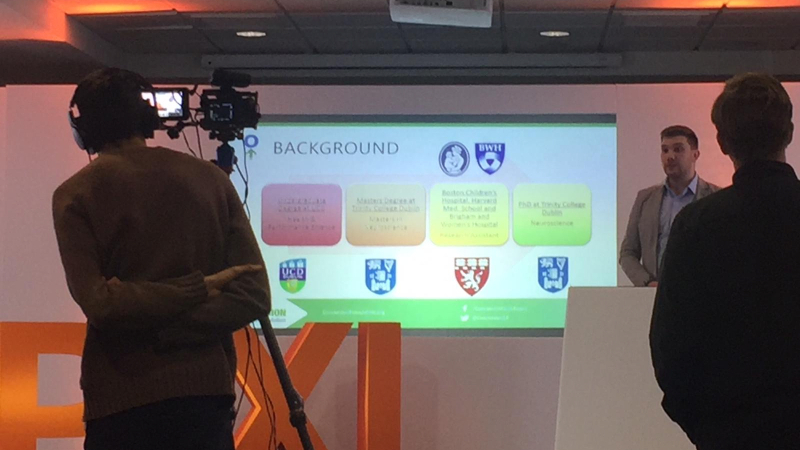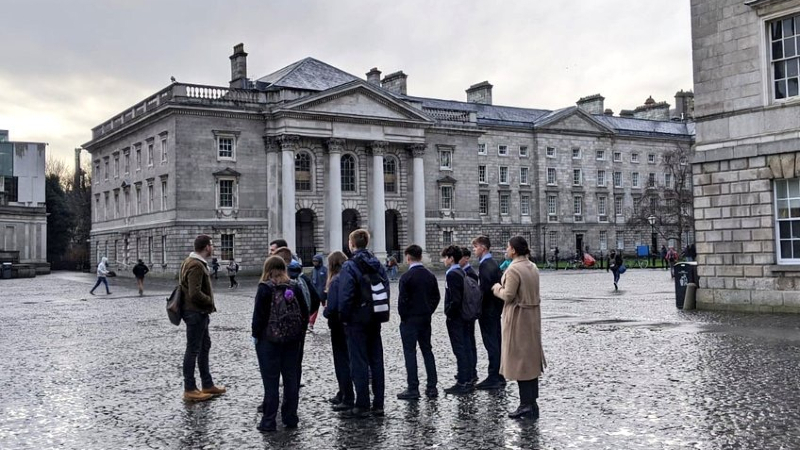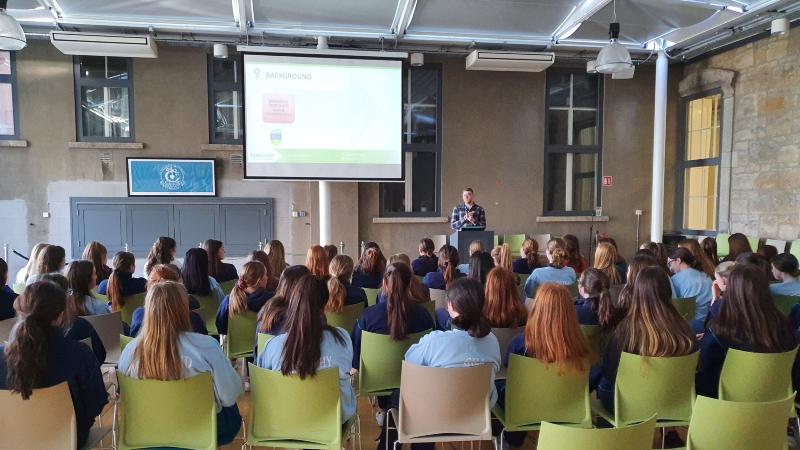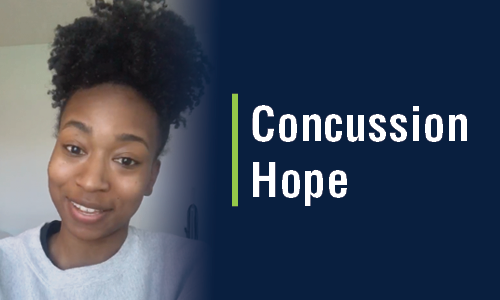Get Inspired
Team Up Against Concussions in Ireland
Oisín Joyce is a Ph.D. student at Trinity College in Dublin, Ireland studying sports concussions and traumatic brain injuries. Oisín reached out to CLF in January 2019 asking how he could help bring concussion education to students in Ireland. We sent him our Team Up Against Concussions (TUAC) curriculum and he’s since presented multiple times to huge crowds of student athletes in Ireland. We caught up with Oisín in this Q&A to ask him about the success he’s had so far presenting TUAC, what he enjoys about the presentations, and what’s next for him.

Posted: June 11, 2020
By, Brandon Boyd
Could you tell us a little bit about yourself?
My name is Oisín Joyce and I am currently a Ph.D. student at Trinity College Dublin, Ireland in the area of sports concussion and traumatic brain injury. The current focus of my research is to investigate the utility, reliability and validity of an objective test of multi-sensory integration in the hopes it would aid in the diagnosis, prognosis and recovery following a concussive incident. When I was a child, I always wanted to be a superhero and try to help people. Although my hope of acquiring superpowers remains, with age comes perspective and a degree of realism. So, for now the cape and cowl have been substituted for science and research. My interest in concussion began during my undergraduate degree in Health and Performance Science in UCD, where I received a lecture on the physiology and management of concussion from a Ph.D. student who is now a very good friend of mine. I became captivated with the science and implications surrounding concussions, not only from sporting scenarios but also a clinical standpoint. It is fascinating how much we know and yet how little we understand at the molecular level and the underlying pathology associated with concussion. It was that lecture that was the catalyst to undertake my master’s degree in Neuroscience at Trinity College Dublin and conduct a research project in the area of sports concussion.

Why did you want to get involved with CLF?
Following on from my master’s degree I worked as a research assistant II in Boston Children’s Hospital and as a research associate in Brigham and Women’s Hospital in Boston for a year. There, I investigated novel therapeutic targets for the treatment of concussion through small molecule arrays, alongside the development of objective and diagnostic tools for the identification of concussion and CTE in both a clinical and sports setting through animal models. Throughout my research and reading I began to get a sense that there was a lack of sound and understandable scientific information being translated to the general public and sporting bodies, and I wanted to try and reach out to my local communities back in Ireland and develop an educational outreach program alongside my doctoral studies. It was during this time in Boston that I came across CLF. I reached out wanting to get involved as an ambassador and work with them in Ireland to educate student-athletes about concussions through discussion, video, and interactive games, teaching them that successful athletes play hard and play smart.
How have those presentations gone?
I have had great success since my return to Ireland as a CLF ambassador with my educational outreach. I became a tutor for Scholars Ireland of AccessEd NGO at Trinity College. It is here that I have paired my work with CLF to provide a seven-week course discussing the basics of the brain, the science of concussion and appropriate management, and the definition of CTE. So far, I have undertaken this course with two secondary schools. Additionally, I have presented to multiple crowds of approximately 100 teenage students during health and wellness week and further talked to them about career paths in neuroscience. From these talks I had the heads of the schools come to me asking for me to talk to individual sports teams and specifically to the faculty regarding the appropriate return to education guidelines and rehabilitation management.
What has the response been like to the presentations from students and faculty?
I have received excellent responses from both students and faculty from the presentations I have given so far. They seem to really appreciate the talk and find it very informative. Many were unaware how many career paths are available in the realm of concussion research and neuroscience; they found the talk fascinating and the students got loads out of it. One administrator told me, “The students who attended the presentation were telling the other students about it which is probably the best compliment I can give you!”

What are the biggest misconceptions people have about concussions before the presentations?
Throughout all my presentations I make a point to debunk some common myths surrounding concussion. The one that comes up time and time again is that people believe concussions only happen when you get a hit to the head, but a look of surprise comes over their faces when I tell them concussions can also occur when you get a hit anywhere on the body and the resulting force is transmitted to the head causing a concussion. Furthermore, many people believe concussions only happen in contact and combat based sports, which is not true. It is true some high-speed sports or contact sports may possess a higher risk of concussion than others. But concussions can happen at any place, any time. On the pitch or on the running track. On the playground or when riding a bike or merely a slip or fall!
This can be somewhat frightening for some audience members. To address these concerns, I always conclude each presentation by asking the audience if we should be afraid of concussions. The answer is always no, we should not. There is a lot of talk as to whether parents no longer think sports are safe for their children to engage in due to the potential risk that they may suffer a concussion. But I personally think sport is one of the most purposeful and foundational activities that a child can engage in for several reasons. The first being exercise. From iPads to iPhones, PlayStations and Xboxes, the number of handheld and gaming devices out there now is overwhelming. But equally the number of devices and platforms out there almost equals the number of sports available to children. Too much screen time and lack of exercise is contributing to an unhealthy and sedentary lifestyle.
Rather than holding kids out of sports for fear of concussion, the most important thing is to make sure kids are playing sports as safely as possible. That means minimizing the amount of head impacts kids are taking and making sure any potential concussion receives proper medical care.

What is your favorite part of the Team Up Against Concussions presentations?
The active engagement with the audience. I love getting volunteers up early in the presentation to help me demonstrate the signs and symptoms of concussion. It’s always fun to see volunteers demonstrate what it is like to have blurry vision following a concussion and how that affects their perception of their surroundings.
What inspires you to keep going and do more presentations?
Knowing that for every time that I do one presentation it provides me with a larger platform to disseminate the most up to date and translatable concussion facts. One presentation leads me to another and another and before I know it I have presented to over a thousand students and faculty, all of which will have the appropriate knowledge to identify and understand the signs and symptoms respectively and act in a way that will reduce the time spent in recovery and return to both sport and education in the safest and shortest amount of time possible.
What’s next for you?
In the future I aim to continue my educational outreach with CLF alongside my doctoral studies in hopes of reaching a larger audience that will hopefully facilitate change in some aspects of sporting law across the country of Ireland. I also hope the current research I am conducting will create a more versatile and alternative approach to concussion diagnostics that accounts for the underlying pathology of the injury correlating with representative signs and symptoms.
If you’re interested in bringing concussion education to your community via the Team Up Against Concussions curriculum like Oisin, reach out to CLF's Education Content Manager Brandon Boyd at bboyd@concussionfoundation.org for more information.
You May Also Like

Find out how you can help us get one step closer to finding a cure for CTE by taking the #MyLegacyPledge to donate your brain to research.
Build Your Legacy
We are committed to filling concussion patients with hope and encouragement. Add your voice to the mix with a personal video message for those suffering.
Concussion Hope